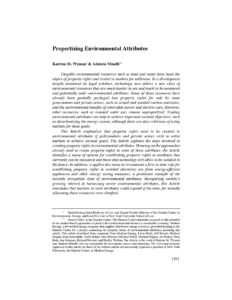Tangible environmental resources such as land and water have been the object of property rights and traded in markets for millennia. In a development largely unnoticed by legal scholars, technology now allows a new class of environmental resources that are much harder to see and touch to be measured and potentially sold—environmental attributes. Some of these resources have already been partially packaged into property rights for sale by some governments and private actors, such as actual and avoided carbon emissions, and the environmental benefits of renewable power and electric cars. However, other resources, such as avoided water use, remain unpropertized. Trading environmental attributes can help to achieve important societal objectives, such as decarbonizing the energy system, although there are also criticisms of using markets for these goals.
This Article emphasizes that property rights need to be created in environmental attributes if policymakers and private actors wish to enlist markets to achieve societal goals. The Article explains the steps involved in creating property rights in environmental attributes. Drawing on the approaches already used to create property rights in some of these attributes, the Article identifies a menu of options for establishing property rights in attributes that currently can be measured and those that technology will allow to be isolated in the future. In addition, it applies this menu to recommend a first-in-time rule for establishing property rights in avoided electricity use from energy-efficient appliances and other energy saving measures, a prominent example of the recently recognized class of environmental attributes. Recognizing society’s growing interest in harnessing newer environmental attributes, this Article concludes that markets in such attributes could expand if the rules for initially allocating these resources were clarified.
